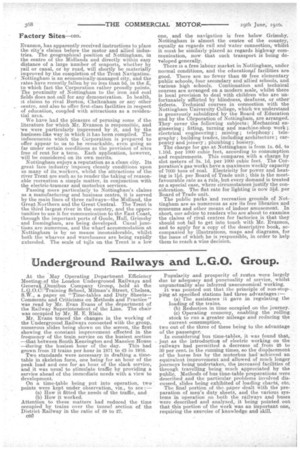Underground Railways and L.G.O. Group.
Page 20

If you've noticed an error in this article please click here to report it so we can fix it.
At the May Operating Department Efficiency Meeting5,of the London Underground Railways and GeneralCOmnibus Company Group, held at the L.qo.c:i.Training School, Milman's Street, Chelsea, S.W., a paper on "Time-tables and Duty Sheets— Comments and Criticisms on Methods and Practice" was read by Mr. Evan Evans of the department of the Railway Superintendent of the Line. The chair was occupied by Mr, H. E. Blain.
Mr. Evans traced the changes in the working of the Underground Railways connected with the group, numerous slides being shown on the screen, the first. showing the constant improvement effected in the frequency of the train service on the busiest section —that between South Kensington and Mansion House —during the busiest hour of the day. This had grown from 12 trains per hour in 1871 to 43 in 1916. Two standards were necessary in drafting a. timetable in skeleton form, one being for an hour of the peak load and one for an hour of the slack service, and it was usual to stimulate traffic by providing a service ahead of the immediate needs with a view to development.
On a time-table being put into operation, two points were kept under observation, viz., to see : (a) Row it fitted the needs of the traffic, and (b) How it worked.
Attention to these matters had reduced the time occupied by trains over the tunnel section of the District Railway in the ratio of 49 to 27. c66 Popularity and prosperity ofroutes were largely due to' adequacy and punctuality of service, whilst unpunctuality also inferred uneconomical working. It was pointed out that the principle of non-stopping at specified stations had three advantages :— (a) The assistance it gave in regulating the loading of the trains. (b) Reduction in time occupied on the journey. (c) Operating economy, enabling the rolling stock to run a. greater mileage and reducing the current consumption, two out of the three of these being to the advantage of the passenger.
In considering bus time-tables, it was found that, just as the introduction of electric working on the railways had permitted a, decrease of from 25 to 30 per cent. in the running times, so the displacement of the horse bus by the motorbus had achieved an equivalent improvement and allowed of much longer journeys being undertaken, the increased facilities of through travelling being much appreciated by the public. Methods of bus time-table preparations were described and the particular Problems involved discussed, slides being exhibited of loading charts, etc.
The final portion of the paper dealt with the preparation of men's duty sheets, and the various systems in operation on both the railways and buses were described and analysed, it being pointed out that this portion of the work was an important one, requiring the exercise of knowledge and skill.






























